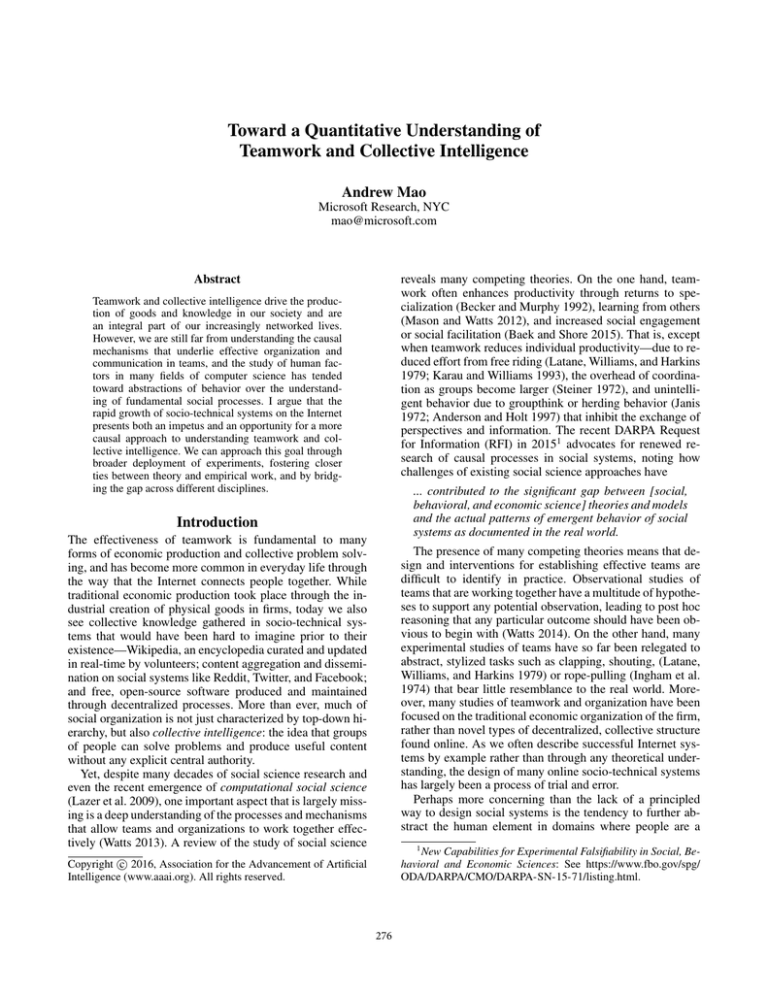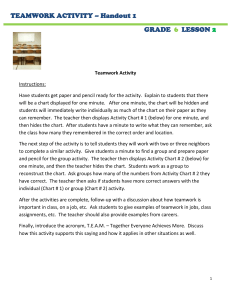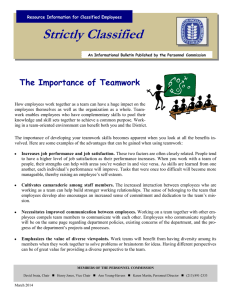
Toward a Quantitative Understanding of
Teamwork and Collective Intelligence
Andrew Mao
Microsoft Research, NYC
mao@microsoft.com
reveals many competing theories. On the one hand, teamwork often enhances productivity through returns to specialization (Becker and Murphy 1992), learning from others
(Mason and Watts 2012), and increased social engagement
or social facilitation (Baek and Shore 2015). That is, except
when teamwork reduces individual productivity—due to reduced effort from free riding (Latane, Williams, and Harkins
1979; Karau and Williams 1993), the overhead of coordination as groups become larger (Steiner 1972), and unintelligent behavior due to groupthink or herding behavior (Janis
1972; Anderson and Holt 1997) that inhibit the exchange of
perspectives and information. The recent DARPA Request
for Information (RFI) in 20151 advocates for renewed research of causal processes in social systems, noting how
challenges of existing social science approaches have
Abstract
Teamwork and collective intelligence drive the production of goods and knowledge in our society and are
an integral part of our increasingly networked lives.
However, we are still far from understanding the causal
mechanisms that underlie effective organization and
communication in teams, and the study of human factors in many fields of computer science has tended
toward abstractions of behavior over the understanding of fundamental social processes. I argue that the
rapid growth of socio-technical systems on the Internet
presents both an impetus and an opportunity for a more
causal approach to understanding teamwork and collective intelligence. We can approach this goal through
broader deployment of experiments, fostering closer
ties between theory and empirical work, and by bridging the gap across different disciplines.
... contributed to the significant gap between [social,
behavioral, and economic science] theories and models
and the actual patterns of emergent behavior of social
systems as documented in the real world.
Introduction
The effectiveness of teamwork is fundamental to many
forms of economic production and collective problem solving, and has become more common in everyday life through
the way that the Internet connects people together. While
traditional economic production took place through the industrial creation of physical goods in firms, today we also
see collective knowledge gathered in socio-technical systems that would have been hard to imagine prior to their
existence—Wikipedia, an encyclopedia curated and updated
in real-time by volunteers; content aggregation and dissemination on social systems like Reddit, Twitter, and Facebook;
and free, open-source software produced and maintained
through decentralized processes. More than ever, much of
social organization is not just characterized by top-down hierarchy, but also collective intelligence: the idea that groups
of people can solve problems and produce useful content
without any explicit central authority.
Yet, despite many decades of social science research and
even the recent emergence of computational social science
(Lazer et al. 2009), one important aspect that is largely missing is a deep understanding of the processes and mechanisms
that allow teams and organizations to work together effectively (Watts 2013). A review of the study of social science
The presence of many competing theories means that design and interventions for establishing effective teams are
difficult to identify in practice. Observational studies of
teams that are working together have a multitude of hypotheses to support any potential observation, leading to post hoc
reasoning that any particular outcome should have been obvious to begin with (Watts 2014). On the other hand, many
experimental studies of teams have so far been relegated to
abstract, stylized tasks such as clapping, shouting, (Latane,
Williams, and Harkins 1979) or rope-pulling (Ingham et al.
1974) that bear little resemblance to the real world. Moreover, many studies of teamwork and organization have been
focused on the traditional economic organization of the firm,
rather than novel types of decentralized, collective structure
found online. As we often describe successful Internet systems by example rather than through any theoretical understanding, the design of many online socio-technical systems
has largely been a process of trial and error.
Perhaps more concerning than the lack of a principled
way to design social systems is the tendency to further abstract the human element in domains where people are a
1
New Capabilities for Experimental Falsifiability in Social, Behavioral and Economic Sciences: See https://www.fbo.gov/spg/
ODA/DARPA/CMO/DARPA-SN-15-71/listing.html.
c 2016, Association for the Advancement of Artificial
Copyright Intelligence (www.aaai.org). All rights reserved.
276
fundamental property of an answer to this question is that it
is causal: we can quantify the effect that X had on the performance of a team, and moreover through which mechanisms
it took place. For example, we might imagine that arranging a large team to organize into smaller groups focusing on
sub-tasks improves individual productivity by reducing the
amount of coordination overhead required of each participant.
Answers to questions like these are fundamental to our
ability to design socio-technical systems that function as intended, rather than being continually redesigned through a
process of trial-and-error. In areas such as microtask crowdsourcing and human computation, people—rather than being a problem to abstract away—actually present an opportunity to study fundamental questions of social behavior.
An understanding of the causal mechanisms that affect team
performance will generalize and carry over to many different settings, and in turn allow for answers to broader questions such as how the decentralized organization emerges in
collective intelligence settings, and why some teams and organizations are more effective than others.
fundamental component. A typical approach in computer
science, this is exemplified by much of the work in microtask crowdsourcing, which assumes that humans can be
modeled as noisy computers that make errors with some
probability (e.g. Bachrach et al. 2012), and occasionally respond rationally to economic incentives but with many exceptions (Mason and Watts 2009; Yin, Chen, and Sun 2013;
Ho et al. 2015). Furthermore, much work in human computation focuses on how workflows can be used to decompose complex problems into small tasks that can be done
by workers without specialized skills in a short amount of
time (Dai, Mausam, and Weld 2010; Kulkarni, Can, and
Hartmann 2012).
An obvious question to ask in light of this work is
whether people can simply be reduced via a layer of abstraction to noisy computers motivated by money. Perhaps
the microtasking and workflow approach to collective problem solving effectively dismisses benefits from people being able to interact, coordinate, and collaborate on different tasks—fundamentally a building block of many collectively intelligent systems. Early experiments in collective intelligence have shown that groups of humans can collaborate and benefit from coordination mechanisms for working together and sharing knowledge, both in person and
through electronic media (Woolley et al. 2010; Engel et al.
2014). There is further evidence that intelligent software
systems can mediate and streamline communication within
teams that are tackling a complex task (Zhang et al. 2012;
Kim et al. 2013). By ignoring the social aspects of team collaboration, we may miss some of the intrinsic benefits of
teamwork, as well as opportunities to further enhance and
refine it.
Approaches to studying teamwork
The gold standard for establishing causality is the randomized controlled experiment, because of its ability to systematically eliminate unknown sources of variance across treatment groups—thus establishing treatment conditions as the
only source of variance (Gerber and Green 2012). In the
past, social science experiments on organization and communication in teams have often been limited in size and
scope by the physical laboratories they are conducted in,
leading to stylized tasks done by teams of limited size,
and were eventually abandoned due to lack of progress—
see (Shure and Meeker 1970) for one of many examples.
Zelditch (1969) summarizes the era by asking the rhetorical
question of whether large groups such as an “army” could
be studied experimentally, concluding that it was both unnecessary and infeasible.
However, the growing prominence of online social systems and our primitive understanding of them provides not
only an impetus, but an opportunity to study teamwork
and collective intelligence experimentally. Software systems
connect together many more people than could possibly be
contained in physical labs, while also making it easier to
collect data at scale. For example, Facebook has pioneered
the technique of doing large-scale experiments within social
networks (Eckles, Karrer, and Ugander 2014). In general, it
is natural to study online organization by the Internet itself
as a lab, as it both scales effectively and allows for generalization (Bainbridge 2007). As web applications routinely
connect dozens or hundreds of users together in many different types of tasks, they will allow for new studies of behavior that were previously considered to be methodologically impossible. Our work, for example, uses the digital
volunteer setting of crisis mapping as a novel approach to
studying self-organization in teams of different size (Mao
et al. 2016). We use this task to simultaneously test different theories of team effectiveness in a realistic way, and find
that although social loafing and coordination costs result in
Opportunities in online social systems
Currently, we are at an important crossroads in the study of
teamwork and social organization. Not only are current theories in social science often insufficient for an understanding of how teams work together effectively, they are even
more ill-suited for designing social systems on the Internet,
where organization takes place in novel ways that are less
well understood. However, the process of designing such
systems and the data they capture also offer an opportunity
to both engage in principled study of human behavior and
contribute to a new wave of social science. Instead of using more layers of abstraction when people appear, we can
instead tackle headfirst the challenge of understanding individual and group behavior at a deeper level.
In order to understand how to improve the effectiveness
of teamwork, and of collective social systems at large, we
need to be able to answer questions of the following form in
a quantitative way:
If we apply intervention X to a team working on task
Y, how much more effective does the team become, and
why?
Intervention X may take on many forms, such as a subtle
priming of individuals, changes to the organization or communication structure of a team, or even extensive software
facilitation of a certain aspect of teamwork. However, the
277
discussion from this workshop will steer us down a path toward answering these important questions with far-reaching
consequences.
reduced contribution from individuals in larger teams, the
potential benefits of coordination can outweigh this loss in
raw productivity.
Interdisciplinary research programs will be an integral
part of studying teamwork. While there are many disciplines
effectively studying human behavior, there is a distinct tendency for each field to hold to narrow tribal affiliations, focusing on the methods or discipline rather than the problem
itself (Watts 2013). However, there is a significant benefit
for researchers to overcome these barriers and understand
the tools and perspectives employed by other fields. For example, many computer scientists are relatively new to the
methods and practice of studying collective human behavior, and can learn a great deal from both aforementioned
theories in the social psychology literature and about principles of proper experiment design, such as (Gerber and Green
2012).
Another important approach to studying teamwork is to
more closely integrate the exchange of theory and empirical work. When purely theoretical work proceeds independently of empirical verification, we risk solving poorly
framed problems or developing models that are far removed
from reality. At the same time, conducting experiments without theory to guide hypotheses can lead to poorly designed
experiments or worse, facilitate speculation of spurious post
hoc hypotheses after observing the data. On the other hand,
theory can be used to guide the design of experiments, the
outcome of which can in turn inform better theories and
models of behavior. This cycle can produce better experiment designs as well as more grounded models for teamwork, such as Kleinberg and Raghu (2015).
References
Anderson, L. R., and Holt, C. A. 1997. Information cascades
in the laboratory. The American economic review 847–862.
Bachrach, Y.; Graepel, T.; Minka, T.; and Guiver, J. 2012.
How to grade a test without knowing the answers—a
bayesian graphical model for adaptive crowdsourcing and
aptitude testing. Proceedings of the 29th International Conference on Machine Learning (ICML).
Baek, J., and Shore, J. 2015. Group size and effort per
person: a MOOC field experiment. Working paper.
Bainbridge, W. S. 2007. The scientific research potential of
virtual worlds. science 317(5837):472–476.
Becker, G., and Murphy, K. 1992. The division of labor,
coordination costs, and knowledge. The Quarterly Journal
of Economics 107(4):1137–60.
Dai, P.; Mausam; and Weld, D. S. 2010. Decision-theoretic
control of crowd-sourced workflows. In Proceedings of the
24th AAAI Conference on Artificial Intelligence (AAAI).
Eckles, D.; Karrer, B.; and Ugander, J. 2014. Design and
analysis of experiments in networks: Reducing bias from interference. arXiv preprint arXiv:1404.7530.
Engel, D.; Woolley, A. W.; Jing, L. X.; Chabris, C. F.; and
Malone, T. W. 2014. Reading the mind in the eyes or reading between the lines? theory of mind predicts collective intelligence equally well online and face-to-face. PloS one
9(12):e115212.
Gerber, A. S., and Green, D. P. 2012. Field Experiments. W.
W. Norton.
Ho, C.-J.; Slivkins, A.; Suri, S.; and Vaughan, J. W. 2015.
Incentivizing high quality crowdwork. In Proceedings of the
24th International World Wide Web Conference (WWW).
Ingham, A. G.; Levinger, G.; Graves, J.; and Peckham, V.
1974. The ringelmann effect: Studies of group size and
group performance. Journal of Experimental Social Psychology 10(4):371–384.
Janis, I. L. 1972. Victims of groupthink: a psychological
study of foreign-policy decisions and fiascoes.
Karau, S. J., and Williams, K. D. 1993. Social loafing: A
meta-analytic review and theoretical integration. Journal of
personality and social psychology 65(4):681.
Kim, J.; Zhang, H.; Andr, P.; Chilton, L.; MacKay, W.;
Beaudouin-Lafon, M.; Miller, R. C.; and Dow, S. P. 2013.
Cobi: A community-informed conference scheduling tool.
In Proceedings of the 26th Symposium on User Interface
Software and Technology (UIST).
Kleinberg, J., and Raghu, M. 2015. Team performance with
test scores. In Proceedings of the 16th ACM Conference on
Electronic Commerce (EC), 511–528. ACM.
Kulkarni, A.; Can, M.; and Hartmann, B. 2012. Collaboratively crowdsourcing workflows with turkomatic. In Pro-
Conclusion
Through understanding the causal mechanisms that underlie
team performance, we will gain a principled approach to design social systems that function as intended, and to enhance
teamwork beyond existing forms of hierarchical organization or decentralized collective intelligence. I envision that a
fruit of this vision will allow us to answer questions like the
following:
1. Optimizing beneficial versus detrimental effects. How
do we construct a team environment where social incentives stimulate productivity through engagement and
learning rather than social loafing or decreased willingness to contribute?
2. Computational team formation. Given a large set of potential team members to choose from, how can we combinatorially assemble an “ideal team” to work on a given
type of task? In other words, can we model and predict team performance from individual attributes and relational characteristics?
3. Software facilitation of teamwork. How can we design
user interfaces and software systems that enhance information sharing and communication for teamwork while
minimizing the disruption from coordination costs?
Although these are ambitious topics that are far beyond
the reach of any one person or research group, I hope that the
278
ceedings of the 15th ACM Conference on Computer Supported Cooperative Work (CSCW).
Latane, B.; Williams, K.; and Harkins, S. 1979. Many hands
make light the work: The causes and consequences of social loafing. Journal of personality and social psychology
37(6):822.
Lazer, D.; Pentland, A. S.; Adamic, L.; Aral, S.; Barabasi,
A. L.; Brewer, D.; Christakis, N.; Contractor, N.; Fowler, J.;
Gutmann, M.; et al. 2009. Life in the network: the coming
age of computational social science. Science (New York, NY)
323(5915):721.
Mao, A.; Mason, W.; Suri, S.; and Watts, D. J. 2016. An experimental study of team size and performance on a complex
task. Working paper.
Mason, W., and Watts, D. J. 2009. Financial incentives
and the ”performance of crowds”. In Proceedings of the 1st
Human Computation Workshop (HCOMP), 77–85.
Mason, W., and Watts, D. J. 2012. Collaborative learning in
networks. Proceedings of the National Academy of Sciences
109(3):764–769.
Shure, G. H., and Meeker, R. J. 1970. A computer-based experimental laboratory. American Psychologist 25(10):962.
Steiner, I. D. 1972. Group Process and Productivity. Academic Press Inc.
Watts, D. J. 2013. Computational social science: Exciting
progress and future directions. The Bridge on Frontiers of
Engineering 43(4):5–10.
Watts, D. J. 2014. Common sense and sociological explanations. American Journal of Sociology 120(2):pp. 313–351.
Woolley, A. W.; Chabris, C. F.; Pentland, A.; Hashmi, N.;
and Malone, T. W. 2010. Evidence for a collective intelligence factor in the performance of human groups. science
330(6004):686–688.
Yin, M.; Chen, Y.; and Sun, Y.-A. 2013. The effects of
performance-contingent financial incentives in online labor
markets. In Proceedings of the 27th AAAI Conference on
Artificial Intelligence (AAAI).
Zelditch, Jr., M. 1969. Can you really study an army in the
laboratory? A sociological reader on complex organizations
528–39.
Zhang, H.; Law, E.; Miller, R.; Gajos, K.; Parkes, D.; and
Horvitz, E. 2012. Human computation tasks with global
constraints. In Proceedings of the SIGCHI Conference on
Human Factors in Computing Systems, CHI ’12, 217–226.
New York, NY, USA: ACM.
279





